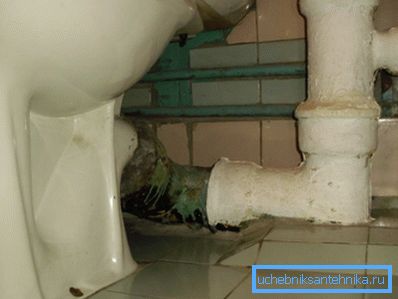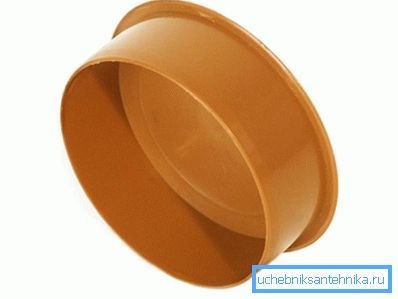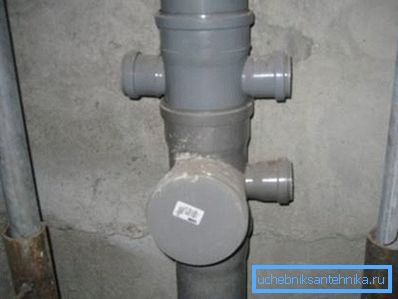Drain cap: how to select and install and how to dismantle
The range of fittings for plumbing today is very large. This is both a plus and a minus. Minus - because it is sometimes difficult for the average consumer to choose the best product option. And the wrong choice, as you understand, is fraught with at least the fact that the operation of the system will not proceed as planned.
It is worth noting that it is difficult to choose not only specific fittings, but also, for example, such a product, simple at first glance, as a sewer plug. The fact is that there are certain nuances that must always be considered before buying.

In this article we will look at how and how to block the sewage cast-iron pipe and plastic. In addition, we will touch upon such a moment as dismantling plumbing plugs for pipes - you will see that everything is not as simple as it seems.

Let's start with a review of the most important point.
Types of caps
Despite the fact that the range of such fittings is small, some significant differences do exist. Consider them in a comparative table.
| Product type | Special features |
| These parts are designed for indoor installation and have almost the same wall thickness. Only the diameter of the product can be different. |
| These plugs are made for outdoor use and may have different weights and different thicknesses of plastic. Fittings that are classified as light and medium type are distinguished by the fact that their price is quite affordable, and in addition the scope of application is operation at a depth of up to three meters. the site is subjected to heavy loads (this may be a parking lot, for example, or a road). |
As you can see, everything is quite clear here, because there are really few selection criteria.

Pay attention to one important point! It is highly desirable that manufacturers have the same pipes and fittings for internal or external sewage. Otherwise, there is a great risk of complications (there are difficulties here, because of the different equipment in the factories, there are errors in the diameter of the products) when they are connected by their own hands.
Let's now look at how to mount this type of connection.
Independent work with plugs for pipes
It should be noted that the assembly instruction will be provided the most general and universal. That is, the scheme will be given such that everyone can apply in practice, without the presence of any expensive tools and consumables.
So, step by step installation of plugs on the sewer.
On a plastic pipe

In this case, you need to act like this:
- The cork is taken and its outer surface is covered with any sanitary silicone. If silicone is not used, there will not be a truly tight connection. And this means that both smells and noise from the flow of various liquids through pipes penetrate the room. (See also the article Connecting the toilet to the sewer: features.)
- There is a special groove inside the pipe outlet - there is, as a rule, a rubber band, which also significantly affects the level of tightness. So if such a rubber gasket is missing, then it must be inserted. In principle, the gum should come from any manufacturer.
- Rubber is also lubricated with silicone.
- The fitting is inserted into the pipe. If the diameter does not match and the part cannot be inserted as expected, then you can try to lubricate it with a small amount of oil and twist it as though.
Note! After the plug for sewer pipes is inserted, you need to leave it for a couple of days alone. That is, do not scroll, do not remove, and then insert again. If you move the fitting, the silicone will not fully dry and the tightness will not be the best.

Agree, work in principle simple.
Now we will consider how to “muffle” pipes made of steel or cast iron.
Metal pipe plugging
As a rule, the metal sewer line is made of either cast iron or steel. In the first case, you can try to find the “native” cover on the flea market, but in the second case you will have to be smart.
In fact, the plug on the sewage pipe made of steel is the same standard plug, but the difficulty is that it is difficult to find the right diameter of the product.
Therefore, if the finished cover was not found, try the following methods:
- Make a piece of wooden chopik, which is treated with silicone or liquid glass. The essence of the method is that if the wooden cork is in contact with water or exposed to moist air, the wood will swell. And due to this property, we get the desired level of tightness and a strong connection.

- Put gidropombu. In fact, this is just a cement mortar that hardens even while under water. Naturally, it should not just be poured into the hole - first, insert something like a lid of strong polyethylene into the pipe so that the mixture does not flow into the riser before solidification.
Tip: in principle, you can plug the hole with a metal plug of a smaller diameter. Just for this you need to wrap it with a layer of tow (up to one centimeter thick), covered with silicone.
And, probably, it is also worth considering how to remove such elements from pipes.
Dismantling traffic jams
Then a logical question arises - what is so complicated about this work?
In fact, there are many nuances.
First, you can have a Sprut sewer plug, which is usually put up because of debt. Its essence is simple - with the help of special equipment, a plug is inserted into the hole of your outlet from the riser, which blocks the drainage of liquid by 97%.

The problem is that the dismantling of such a barrier can lead to fines from the relevant services (although there is still need to prove the legality of the sewer plug for debtors). But even if you close your eyes to the legal aspects of the issue, there is another difficulty - if you just knock out the cork, it can get stuck in the riser, and this is already blocking the discharge of water on all floors.

Therefore, it is better not to risk it, but to apply this method: take the drill, drill and squander the element at the edges, and then remove it carefully.
Secondly, if the riser is cast iron, and the plug is old, then it may simply fail to dismantle it. In most cases, they begin to affect the product with a hammer, and this may entail the destruction of the entire pipe - cast iron is brittle, after all.
And here, too, you can try to use a power tool - make small dotted cuts with a grinder and, as it were, break off the metal in small pieces. Such work will progress slowly, but the probability of deformation of the entire riser as a whole will be low.

This concludes our review and now we will summarize it.
Conclusion
We figured out in sufficient detail in the plugs for pipes. Considered what they are, what to look for when buying and installing such products. In addition, they also touched on how the sewer plug for defaulters is being dismantled.
I want to believe that all this information will be useful to you. And if the information seemed to be small, then we recommend viewing the additional video in this article.